*NURSING > QUESTIONS & ANSWERS > 407 INTEGRATION RN Comprehensive Online Practice B FINAL LUNES ( 150 QUESTIONS WITH 100% CORRECT ANS (All)
407 INTEGRATION RN Comprehensive Online Practice B FINAL LUNES ( 150 QUESTIONS WITH 100% CORRECT ANSWERS-HIGHLIGHTED)
Document Content and Description Below
RN Comprehensive Online Practice 2019 B 1. A nurse is assessing a client who received 2 units of packed RBCs 48 hr. ago. Which of the following findings should indicate to the nurse that the therapy... has been effective? a. Hemoglobin 14.9 g/dl b. WBC count 12000/mm3 c. Potassium 4.8 mEq/L d. BUN 18 mg/dl 2. A nurse working in an emergency department is triaging four clients. Which of the following clients should the nurse recommend for treatment first? a. An older adult client who reports constipation of 4 days. b. A preschooler who has a skin rash. c. An adolescent who has a closed fracture d. A middle adult client who has unstable vital signs. 3. A nurse is caring for a client who has fluid volume overload. Which of the following tasks should the nurse delegate to an assistive personnel (AP)? a. Palpate the degree of edema b. Regulate IV pump fluid rate. c. Measure the client’s daily weight. d. Assess the client’s vital sign. 4. A nurse is preparing to administer mannitol 0.2 g/kg IV bolus over 5 min as a test dose to a client who has severe oliguria. The client weights 198 lb. What is the amount in grams the nurse should administer? (Round the answer to the nearest whole number. Use a leading zero if it applies. Do not use a trailing zero.) a. 18 G 5. A nurse is conducting a physical examination for an adolescent and is assessing the range of motion of the legs. Which of the following images indicates the adolescent is abducting the hip joint? E. La foto que está parado de frente y solo se ven pies que están separados uno del otro hacia afuera. The image, on the adolescent is abducting the hip joint by moving the leg away from the midline of the body. (imagen with patient facing you with her right leg lifted) answer quizlet (es la imagen con el paciente frente a usted con la pierna derecha levantada).6. A nurse is caring for a client who has hyperthyroidism. Which of the following findings should the nurse expect? a. Dry, coarse hair b. Bradycardia c. Tremors d. Periorbital edema 7. A nurse is assessing a school-age child who has bacterial meningitis. Which of the following findings should the nurse expect? a. Nuchal rigidity b. Weight gain c. Tinnitus d. Positive Trendelenburg sign. 8. A nurse is assessing a newborn’s heart rate. Which of the following actions should the nurse take? a. Assess the apical pulse is most accurate when the newborn is in a quiet state. The sound of crying obscures the heart sounds. b. Palpate the radial pulse for 30 seconds. c. Listen to the apical pulse while palpating the radial pulse. d. Auscultate the apical pulse at least 1 min. 9. A nurse is preparing to assist with a thoracentesis for a client who has pleurisy. The nurse should plan to perform which of the following actions? a. Administer a bowel preparation the night before the procedure. b. Place the client on bed rest for 24 hr after the procedure. c. Perform pulmonary function tests following the procedure. d. Instruct the client to avoid coughing during the procedure. 10. A nurse in the emergency department is assessing a preschooler who has a facial laceration. The nurse should identify which of the following findings as a potential indication of child sexual abuse? a. A child exhibits discomfort while walking. b. The child has thin extremities. c. The child has bruises on the upper back. d. The child is wearing a stained shirt.11. A nurse is preparing to teach about dietary management to a client who has Crohn’s disease and an entero-enteric fistula. Which of the following nutrients should the nurse instruct the client to decrease in their diet? a. Calories b. Protein c. Potassium d. Fiber. 12. A nurse is caring for a client who has a prescription for a continuous passive motion (CPM) machine following a total knee arthroplasty. Which of the following actions should the nurse take? a. Turn off the CPM machine during mealtime. b. Maintain the client’s affected hip in an externally rotated position. c. Instruct the client how to adjust the CPM setting for comfort. d. Store the CPM machine under the client’s bed when not in use. 13. A nurse is preparing to initiate IV access for an older adult client. Which of the following sites should the nurse select when initiating the IV for this client? a. Radial vein of the inner arm. b. Great saphenous vein of the leg. c. Dorsal plexus vein of the foot. d. Basilic vein of the hand. 14. A nurse is developing a client education program about osteoporosis for older adult clients. The nurse should include which of the following variables as a risk factor for osteoporosis? a. Obesity b. Acromegaly c. Estrogen replacement therapy. d. Sedentary lifestyle. 15. A nurse in an emergency department is caring for a child who has a fever and fluidfilled vesicles on the trunk and extremities. Which of the following interventions should the nurse identify as the priority? a. Encourage oral fluids. b. Apply topical calamine lotion c. Administer acetaminophen as an antipyretic. d. Initiate transmission-based precautions.16. A nurse is caring for a client who has a clogged percutaneous gastrostomy feeding tube. Which of the following actions should the nurse take first? a. Obtain a prescription for the client to receive an enzyme product. b. Aspirate the client’s tube. c. Flush the client’s tube with 30 ml of water. d. Change the position of the client. 17. A home health care nurse is developing a teaching plan for a client who has a new ileostomy. Which of the following instructions should the nurse include? a. Limit intake of fluids to 1,000 ml daily b. Take a laxative if no stool has passed after 12 hr. c. Empty the appliance when it is one-third to one-half full. d. Change the entire pouch system every 1 to 2 days. 18. A nurse is reviewing the laboratory report of a client who has end-stage kidney disease and received hemodialysis 24 hr ago. Which of the following laboratory values should the nurse report to the provider? a. Platelets 268,000/mm3 b. Calcium 9,2 mg/dL c. WBC 5,200/mm3 d. Sodium 148mEq/L 19. A nurse is caring for four clients. Which of the following tasks should the nurse delegate to an assistive personnel (AP)? a. Evaluate dietary intake for a client who has anorexia. b. Measure the vital signs of a client who just returned from the PACU. c. Arrange the lunch tray for a client who has a hip fracture. d. Assess I&O for a client who is receiving dialysis. 20. A nurse is preparing a client for a paracentesis. Which of the following actions should the nurse take? a. Instruct the client to void. b. Position the client on their left side. c. Insert an IV catheter. d. Prepare the client for moderate (Conscious) sedation.21. A nurse has received change-of-shift report on for assigned clients. For which of the following clients should the nurse intervene to prevent a potential food and medication interaction? a. A client who is receiving verapamil and has a continuous infusion of total parenteral nutrition (TPN b. A client who is taking phenytoin and is requesting a milkshake. c. A client who is receiving a diet high in potassium-rich foods and furosemide by mouth. d. A client who is receiving an MAOI and is requesting a cheeseburger for dinner. 22. A nurse is planning care for a client who has rheumatoid arthritis and has moderate to severe pain in multiple joints. Which of the following actions should the nurse plan to take? a. Perform ADLs for the client to promote rest. b. Allow for frequent rest periods throughout the day. c. Use heat to reduce joint inflammation. d. Develop a daily schedule for acetaminophen up to 6 g/day that covers peak periods of pain. 23. A nurse is caring for a client who is receiving continuous bladder irrigation following a transurethral resection of the prostate. The client reports bladder spasms, and the nurse observes a decreased urinary output. Which of the following actions should the nurse take? a. Increase tension on the urinary catheter. b. Irrigate the catheter with 0.9% sodium chloride irrigation. c. Assist the client to ambulate. d. Remove the urinary catheter immediately. 24. A nurse is assessing a client who has COPD. Which of the following findings should the nurse expect? a. Weight gain. b. Decrease in anteroposterior diameter of the chest. c. HCO3 24 mEq/L. d. pH 7.31 25. A nurse in a community center is providing an educational session to a group of clients about ovarian cancer. Which of the following manifestations of ovarian cancer should the nurse include in the teaching? a. Diarrhea. b. Urinary retention. c. Purulent discharge. d. Abdominal bloating26. A nurse is caring for a client who has active tuberculosis (TB). Which of the following actions should the nurse plan to take to prevent the transmission of the disease? a. Initiate contact precautions for the client upon admission. b. Restrict visitors from entering the client's room during hospitalization. c. Wear a surgical mask while providing care for the client. d. Have the client wear a surgical mask while being transported outside the room. 27. A nurse is caring for a group of clients. Which of the following clients should the nurse attend to _first? a. An older adult client who is anxious and attempting to pull out an IV line. b. A middle adult client who is reporting nausea after receiving pain medication. c. An older adult client who has kidney failure and returned from dialysis 4 hr ago. d. A middle adult client who has a terminal illness and is requesting a visit from the chaplain 28. An RN is observing a licensed practical nurse (LPN) and an assistive personnel (AP) move a client up in bed. For which of the following situations should the nurse intervene? A. The LPN and AP lower the side rails before lifting the client up in bed. B. Prior to lifting the client, the LPN and AP raise the bed to waist level. C. The LPN and the AP grasp the client under his arms to lift him up in bed. D. The LPN and the AP ask the client to flex his knees and push his heels into the bed as they lift. 29. A nurse is preparing to administer insulin to a client via a pen device. Which of the following actions should the nurse take? a. Hold the insulin pen device perpendicular to the client's skin to inject the medication. b. Shake the insulin pen device prior to injecting the medication. c. Withdraw the insulin from the pen device into an insulin syringe. d. Hold the pen device in place for 3 seconds after injecting the insulin. 30. A nurse is caring for a client who has immunosuppression and a continuous IV infusion. Which of the following actions should the nurse take? a. Assess the client's IV site every 8 hr. b. Check the client's WBC count every 48 hr. c. Monitor the client's mouth every 8 hr. d. Change the client's IV tubing every 48 h [Show More]
Last updated: 1 year ago
Preview 1 out of 37 pages
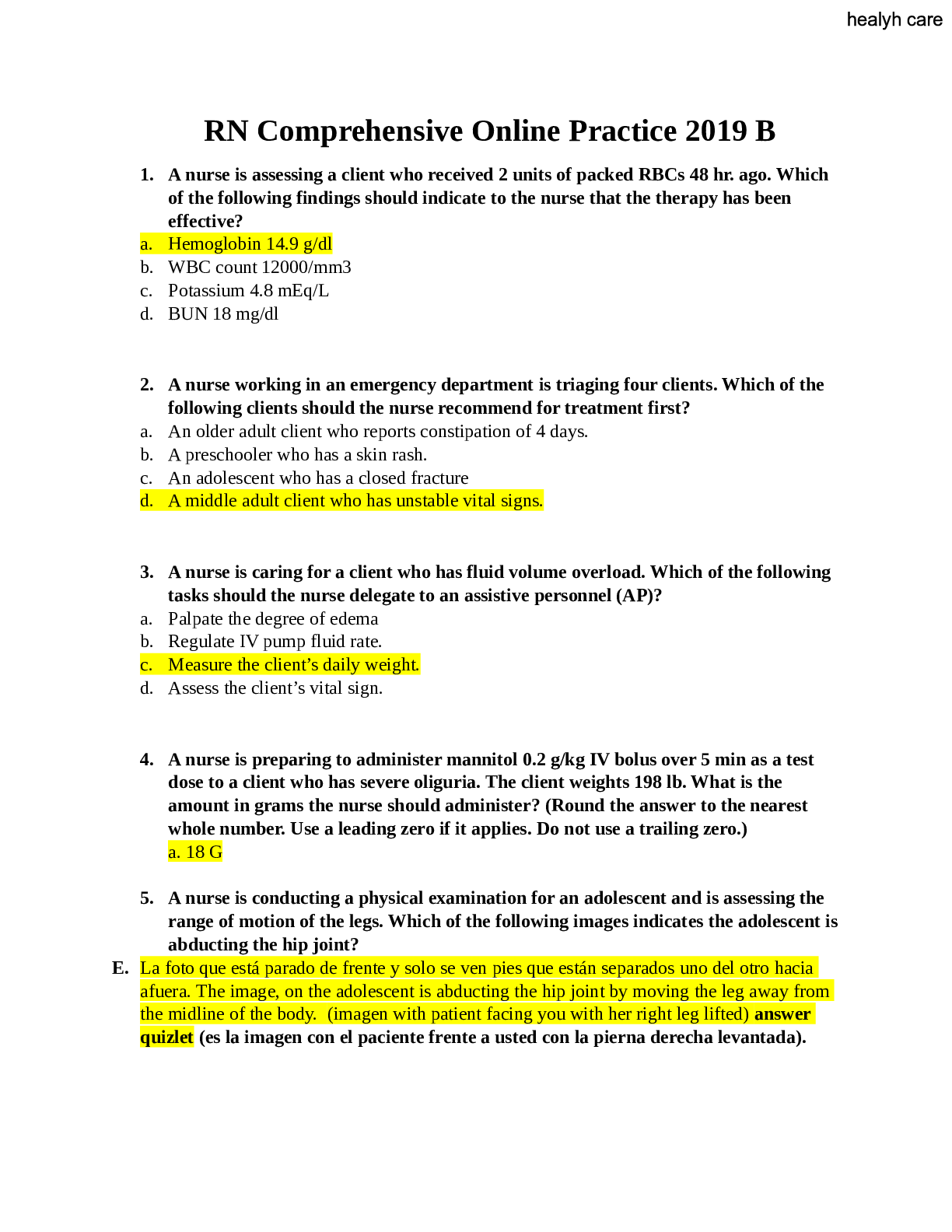
Reviews( 0 )
Document information
Connected school, study & course
About the document
Uploaded On
Aug 14, 2021
Number of pages
37
Written in
Additional information
This document has been written for:
Uploaded
Aug 14, 2021
Downloads
0
Views
37


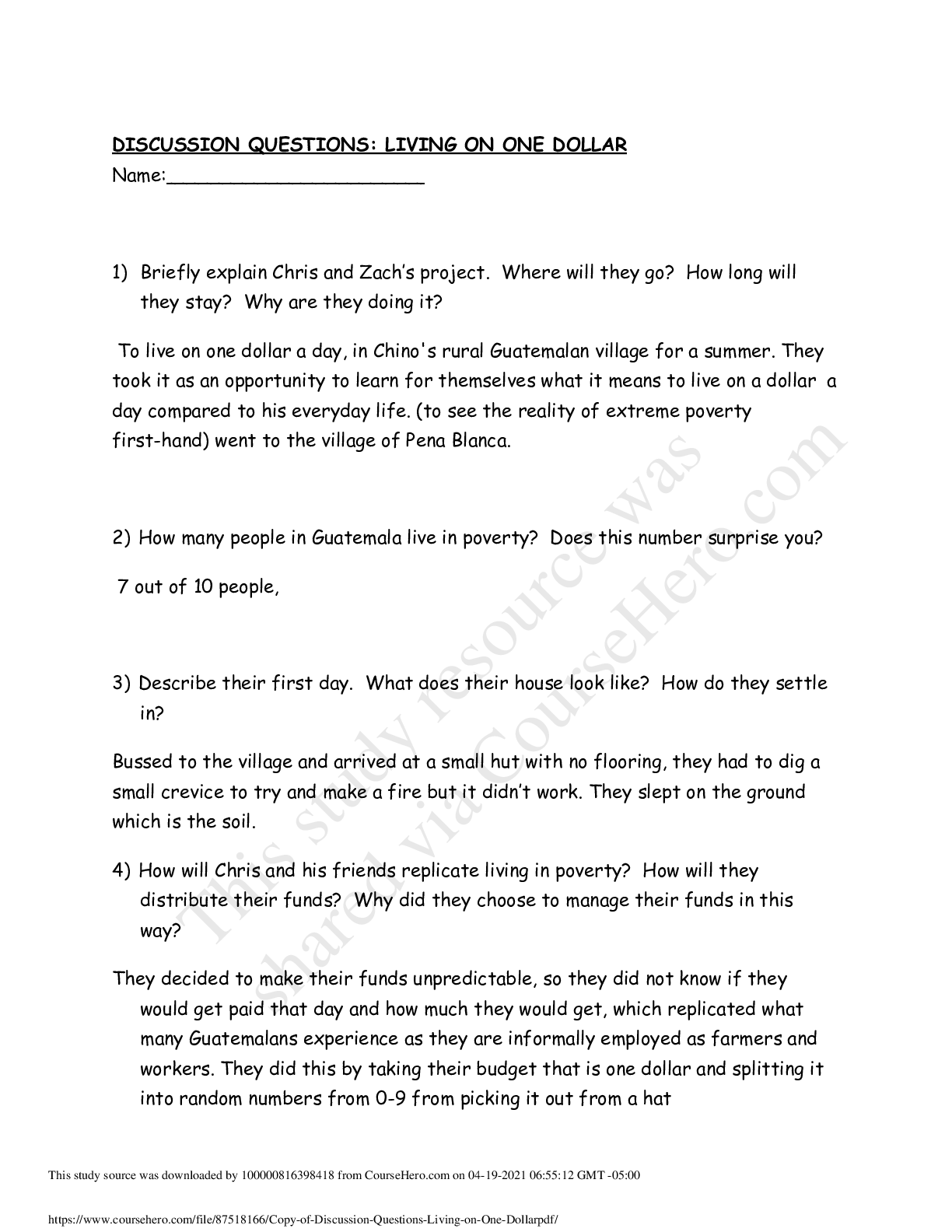
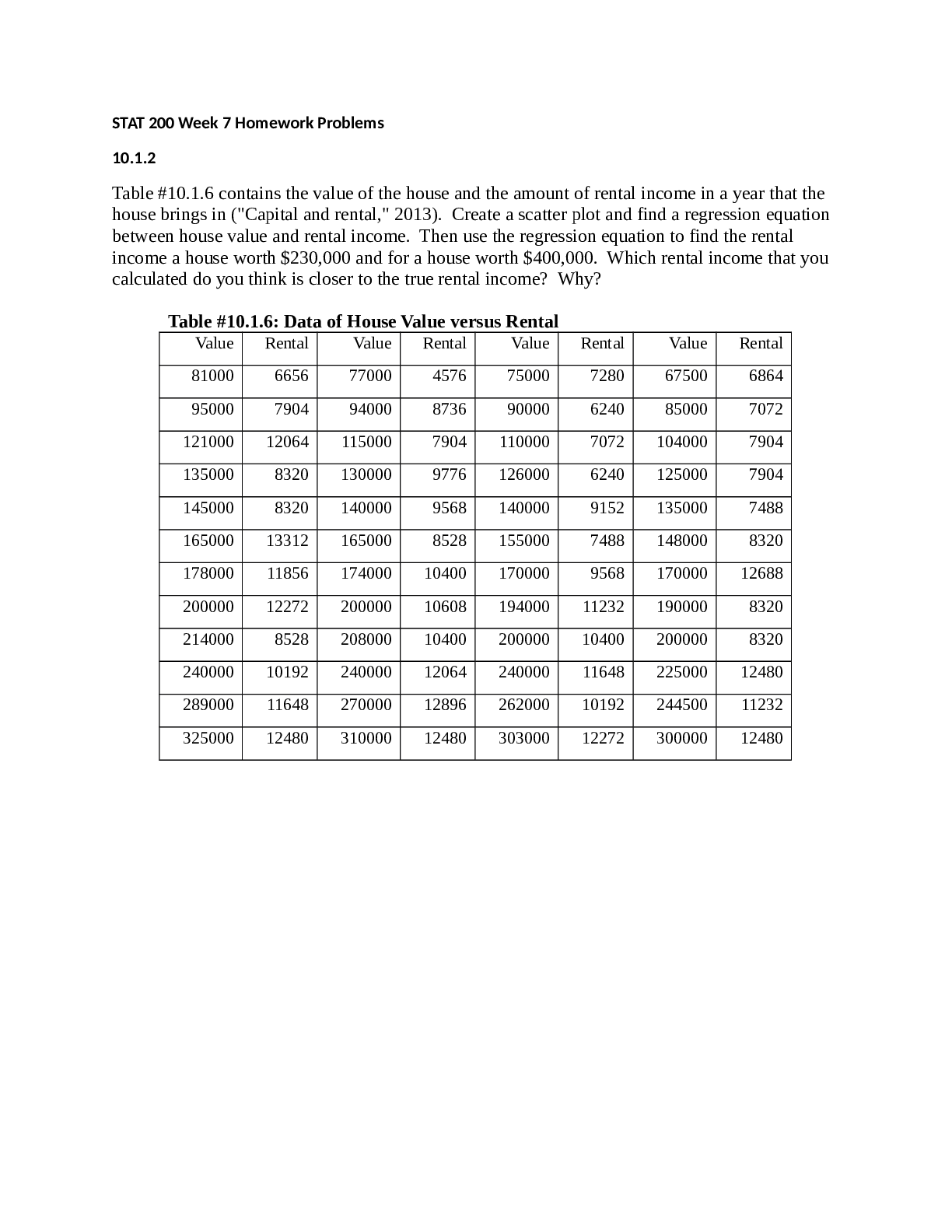
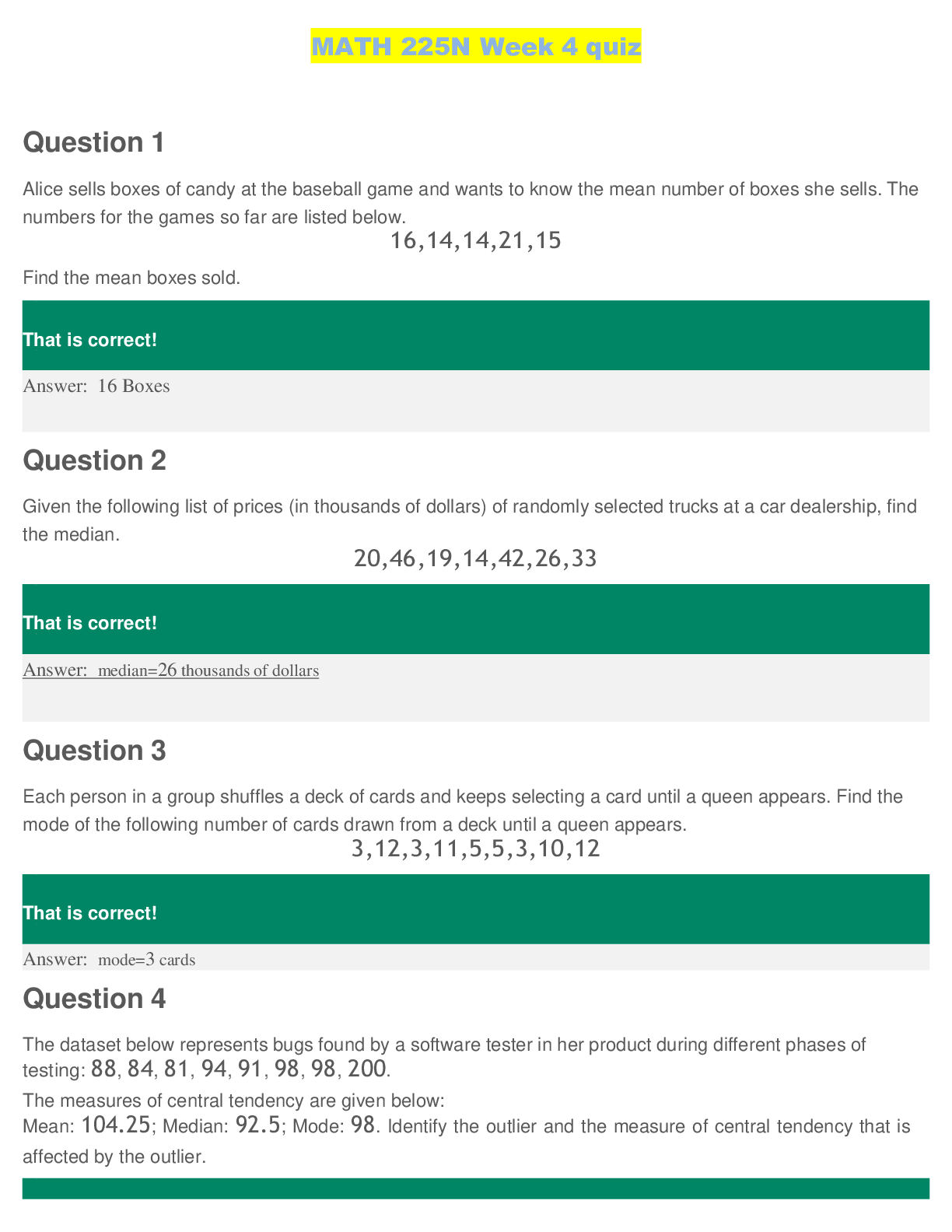


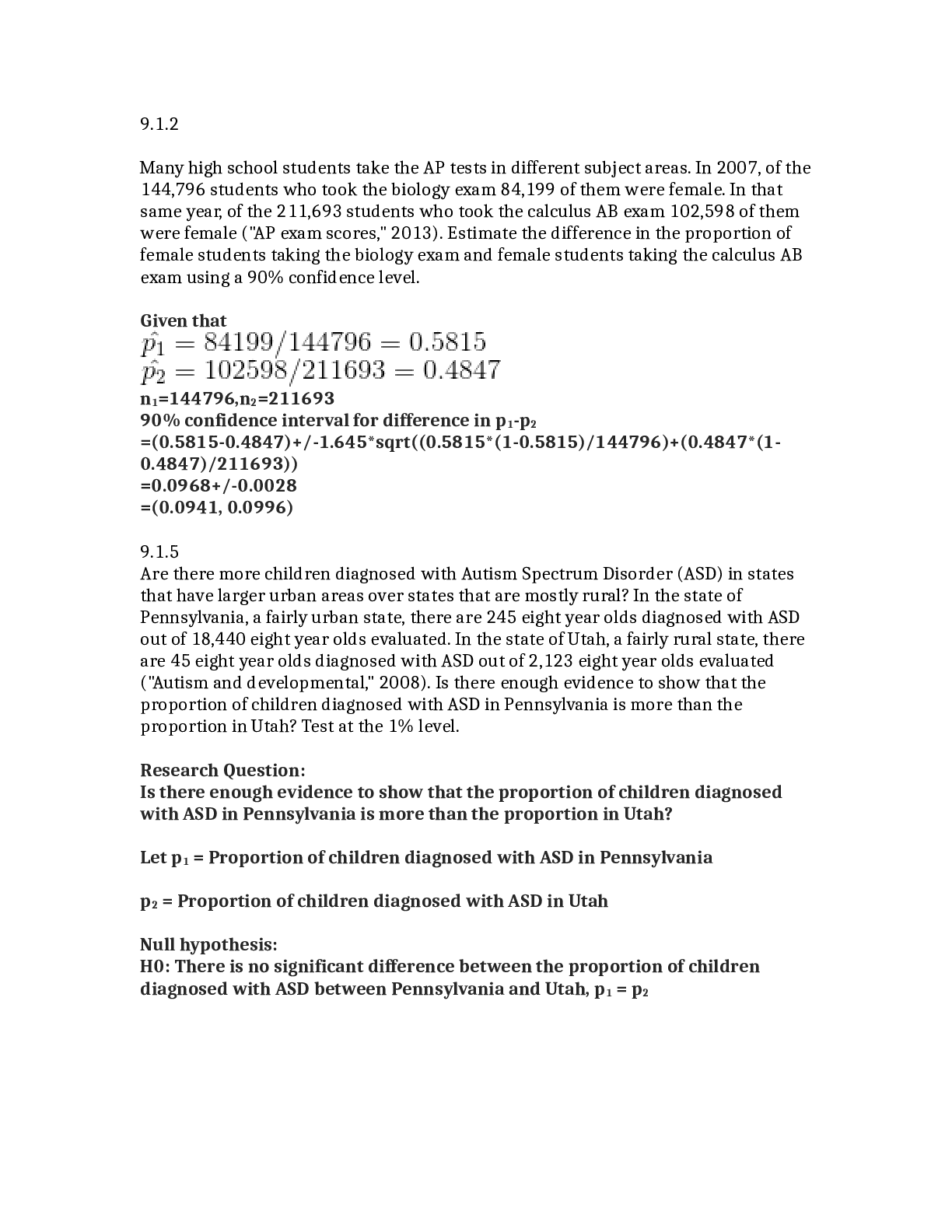
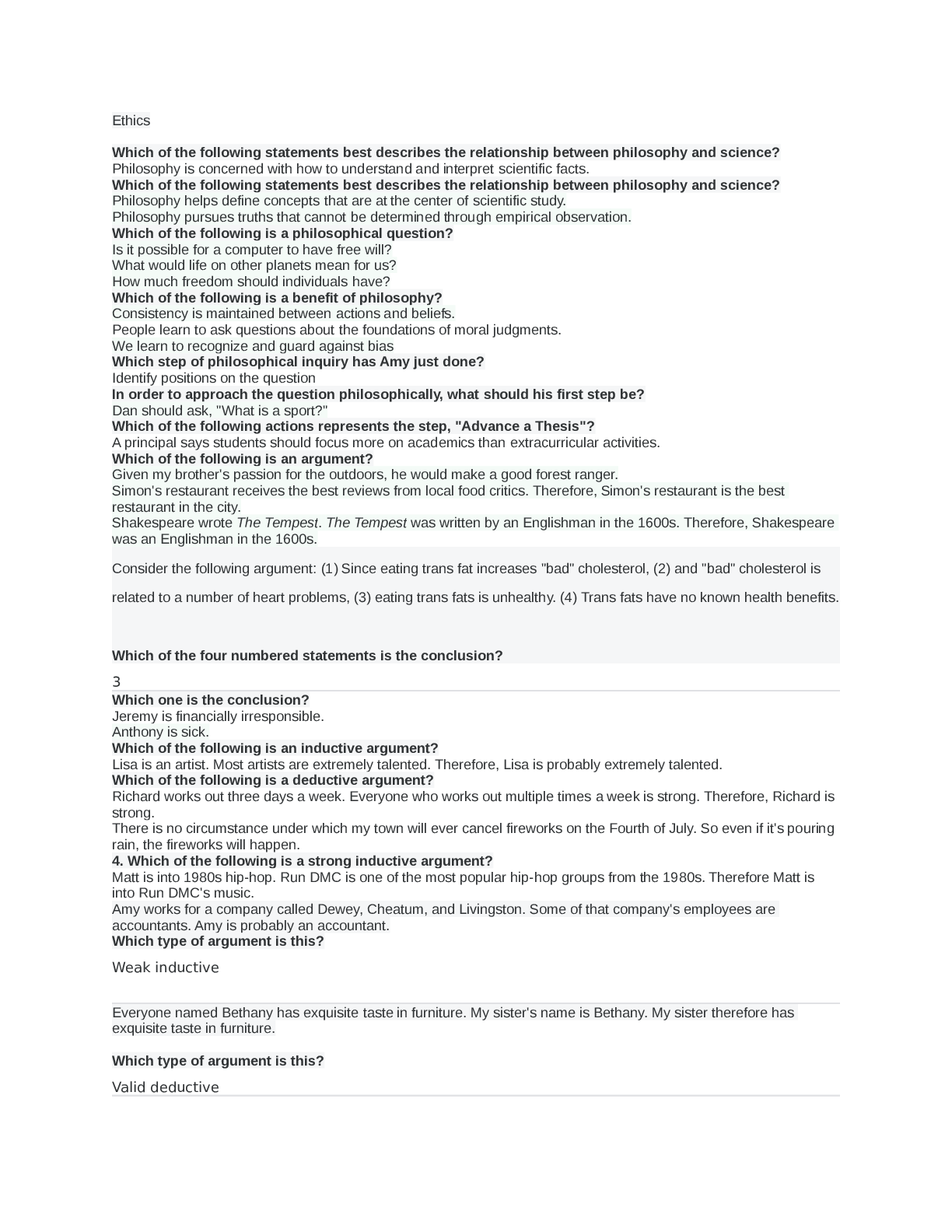
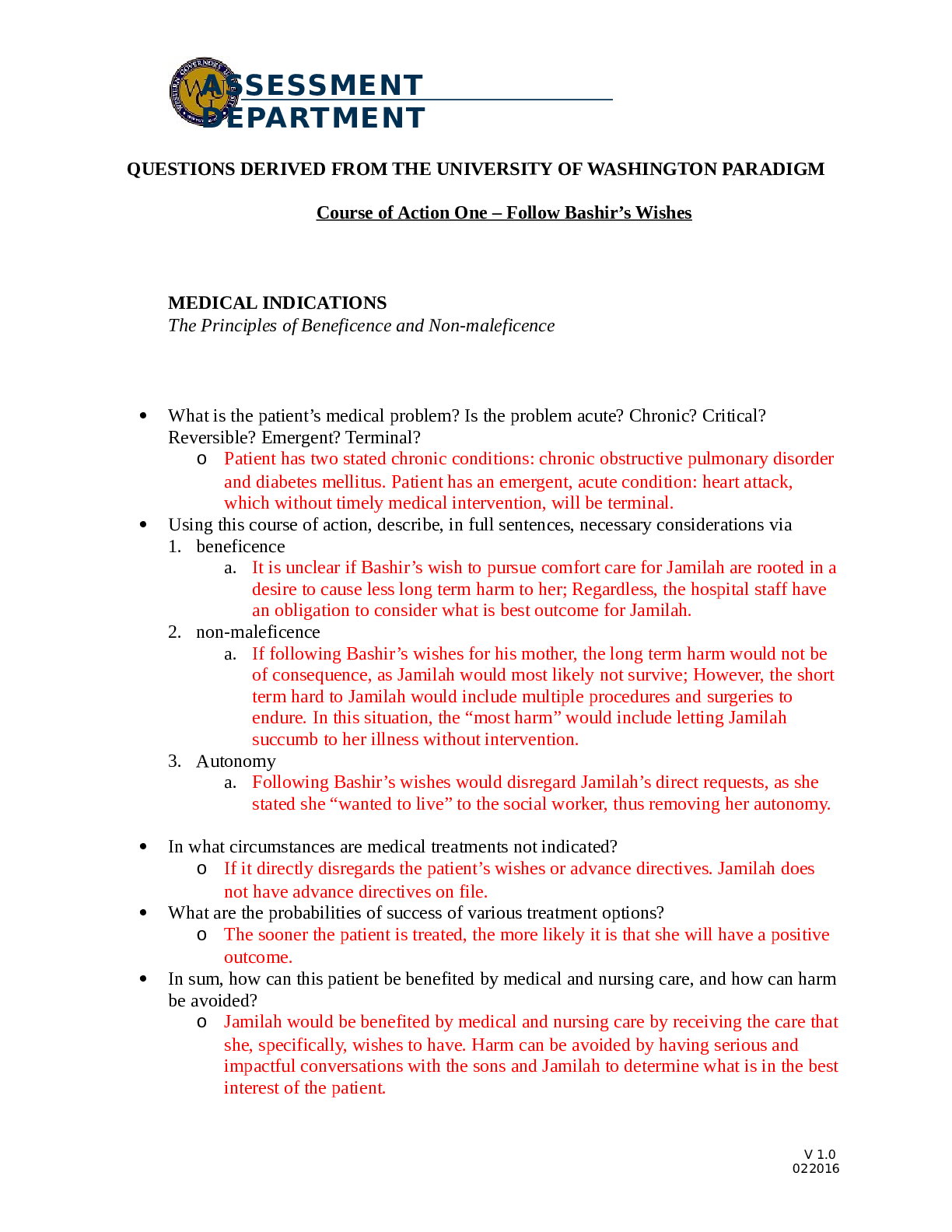
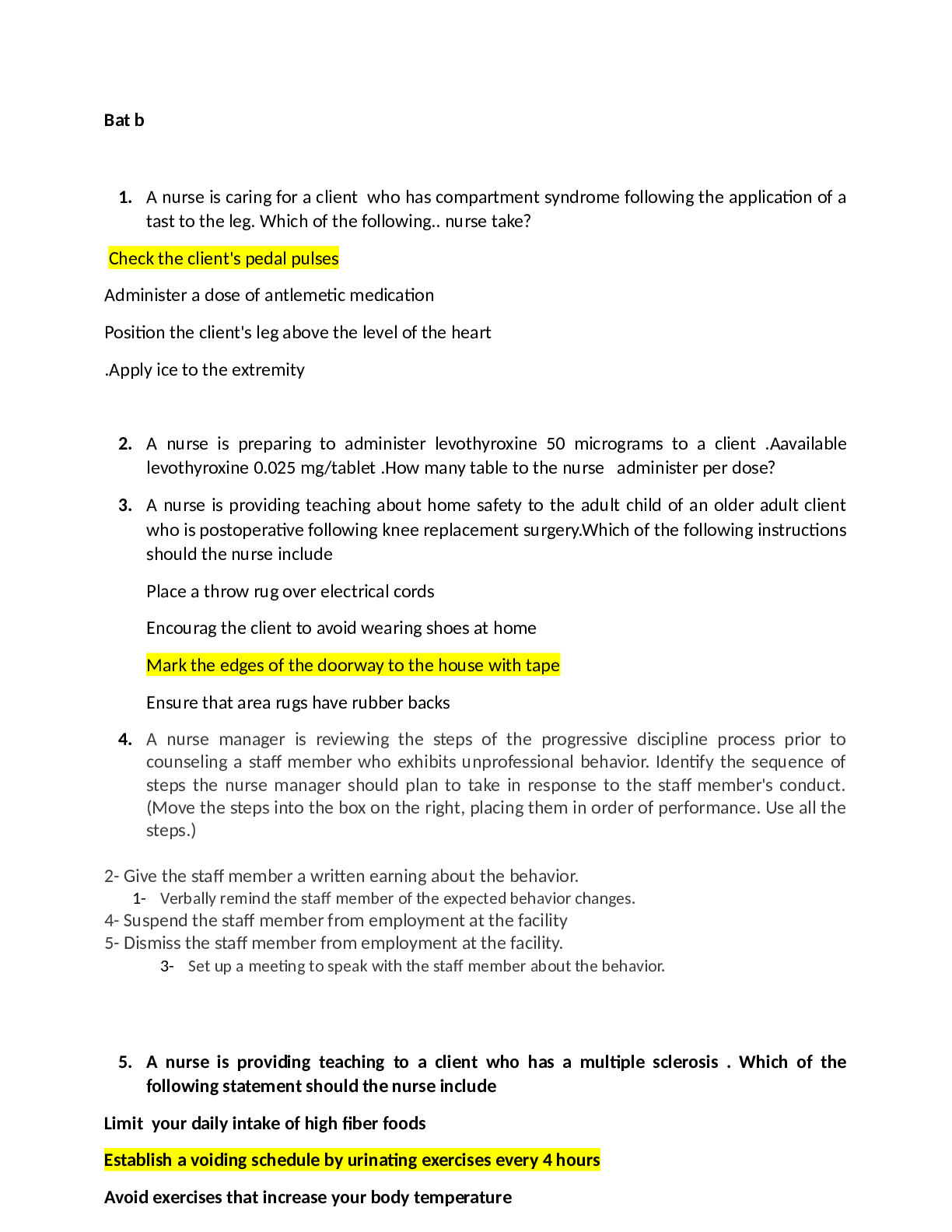


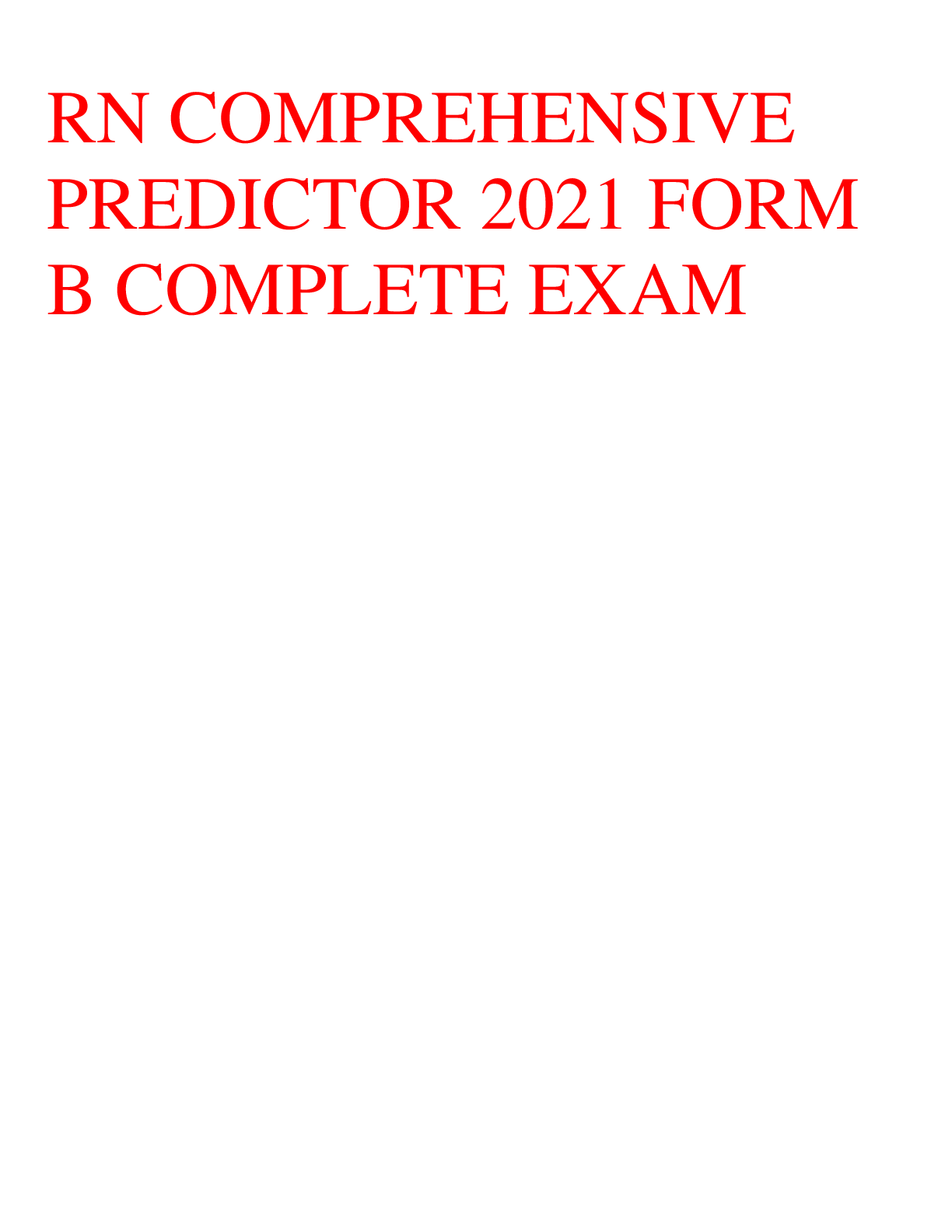

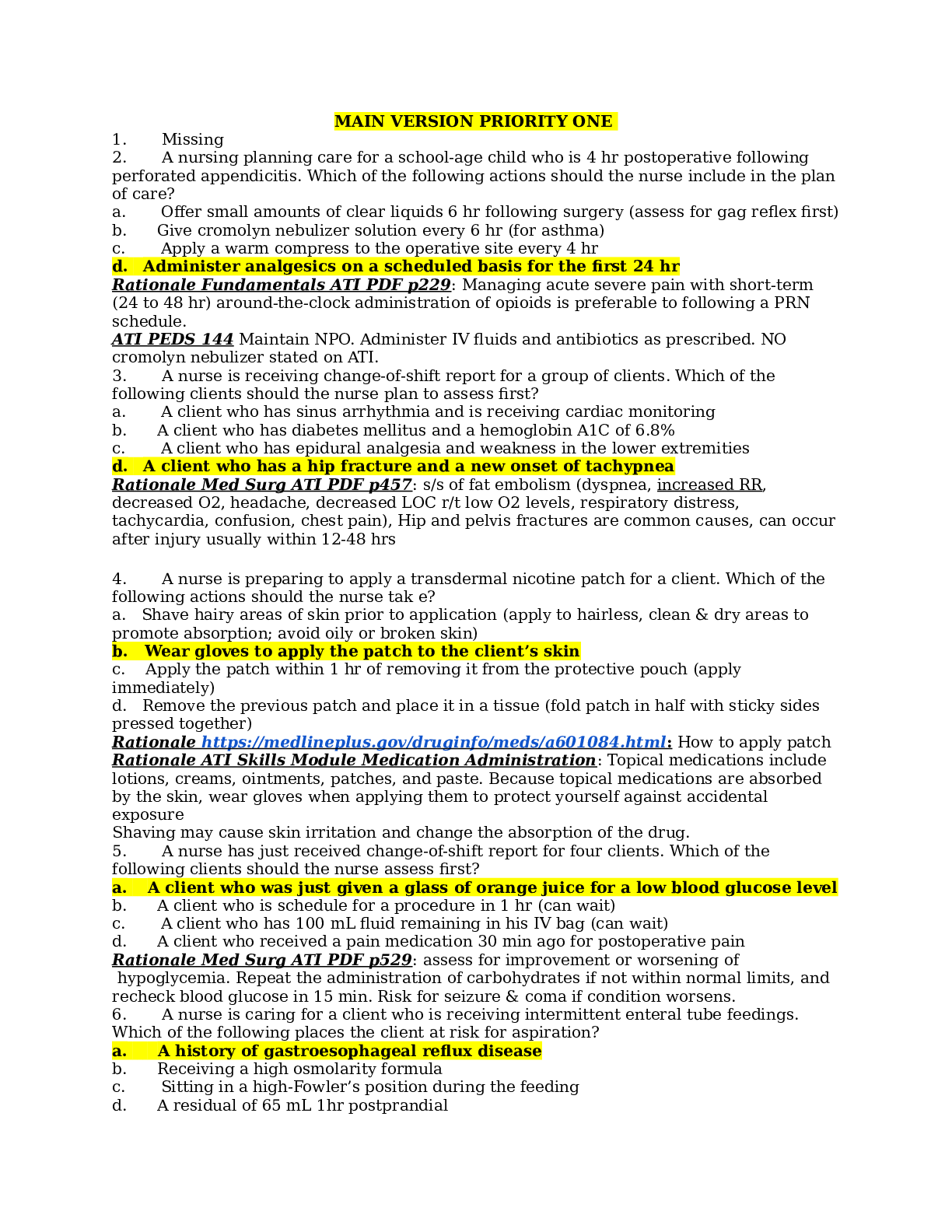


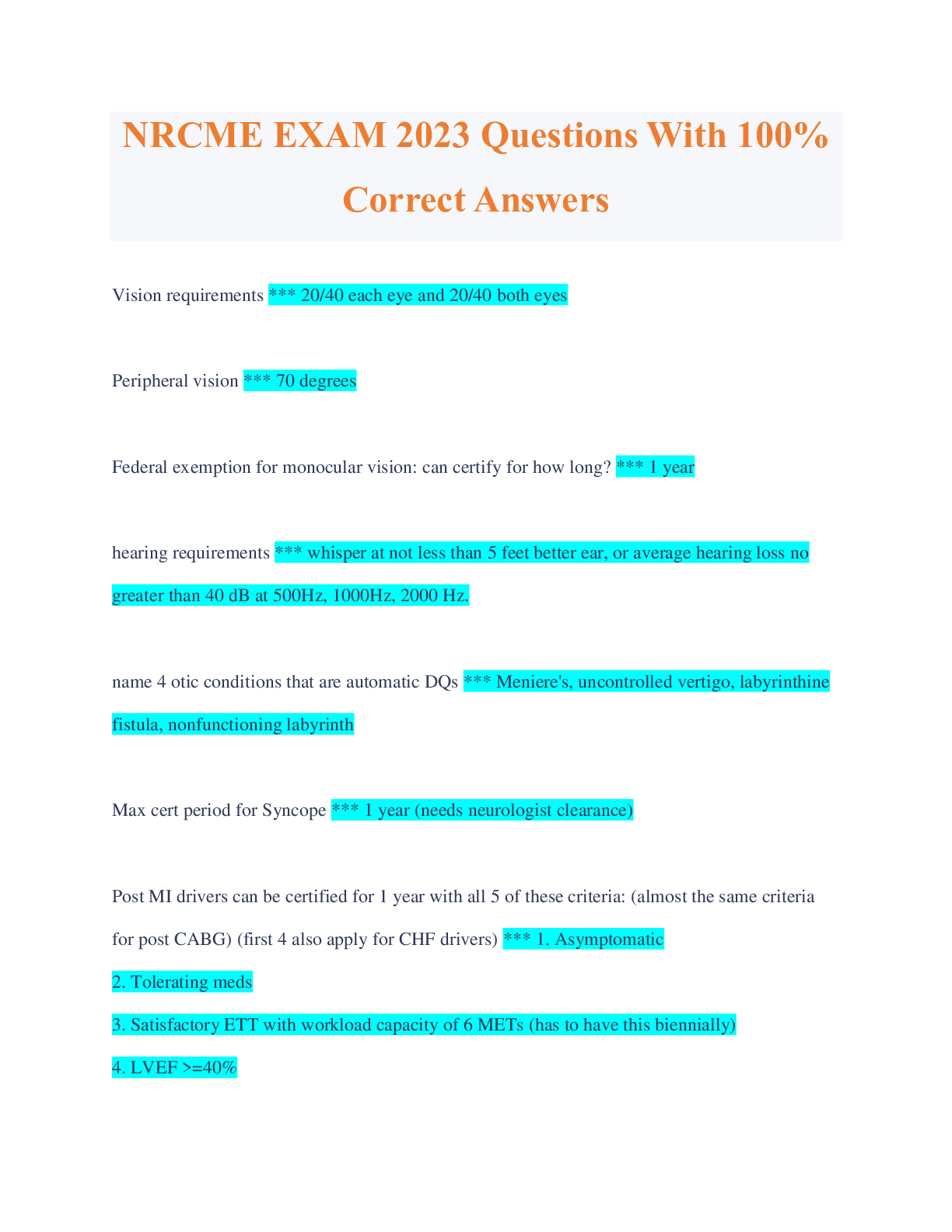

.png)
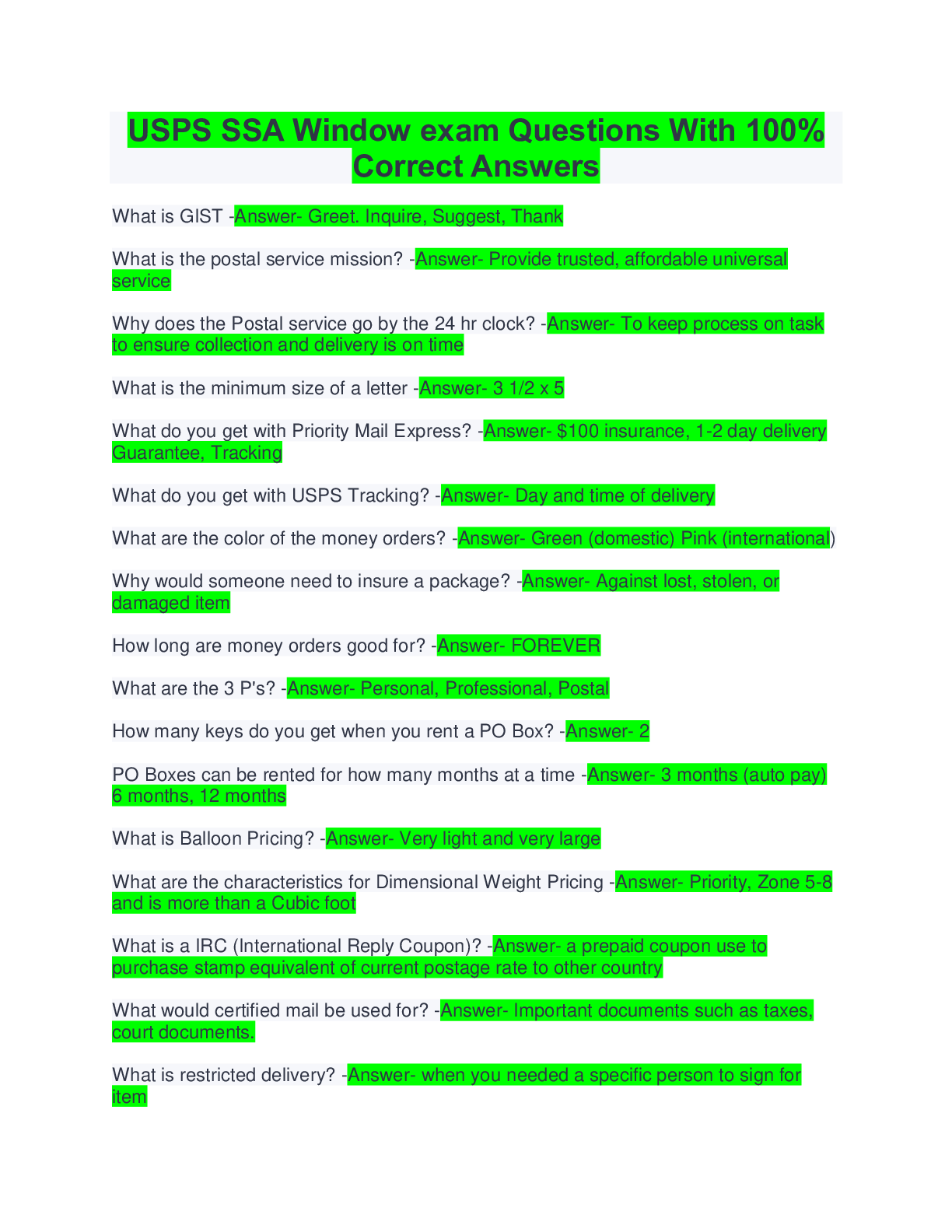
.png)
.png)
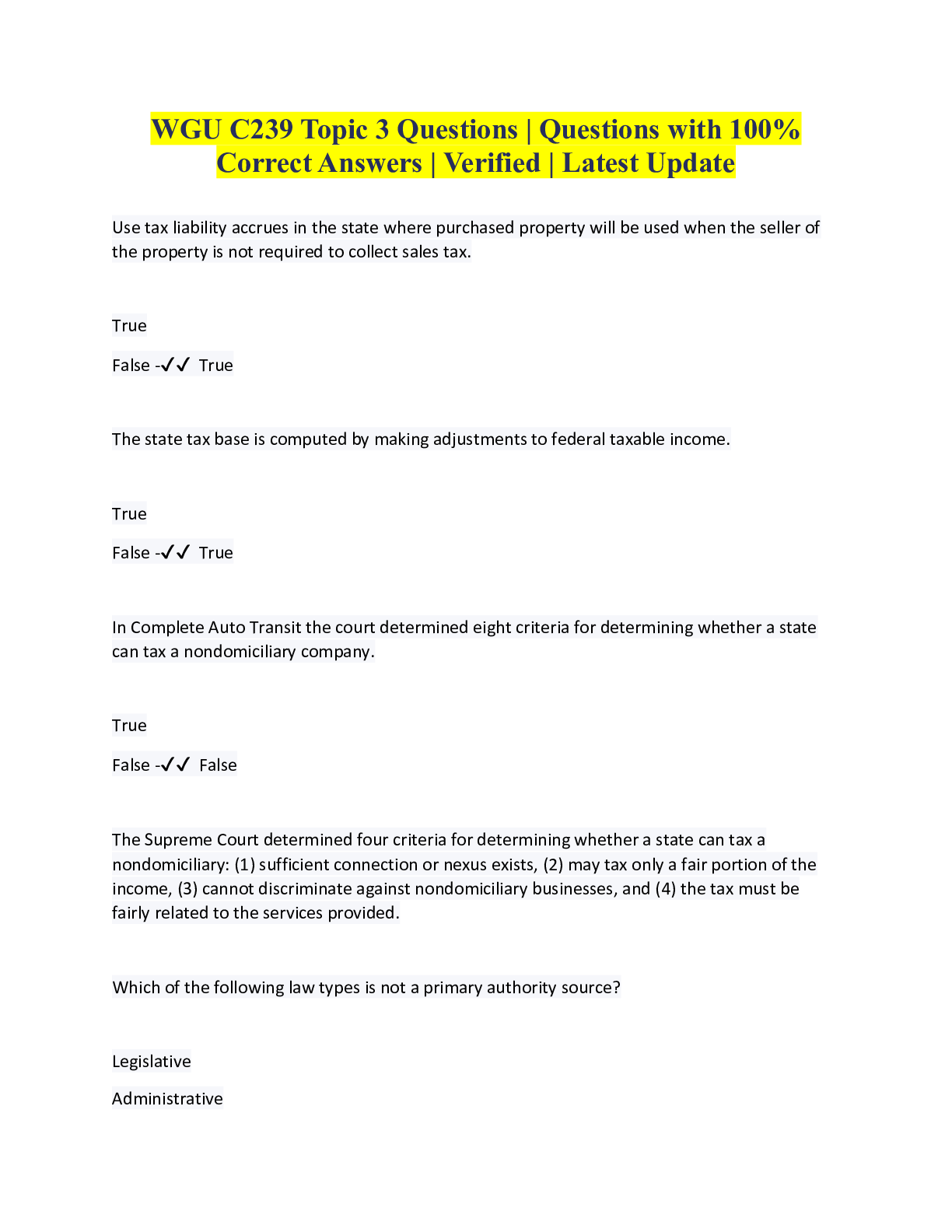
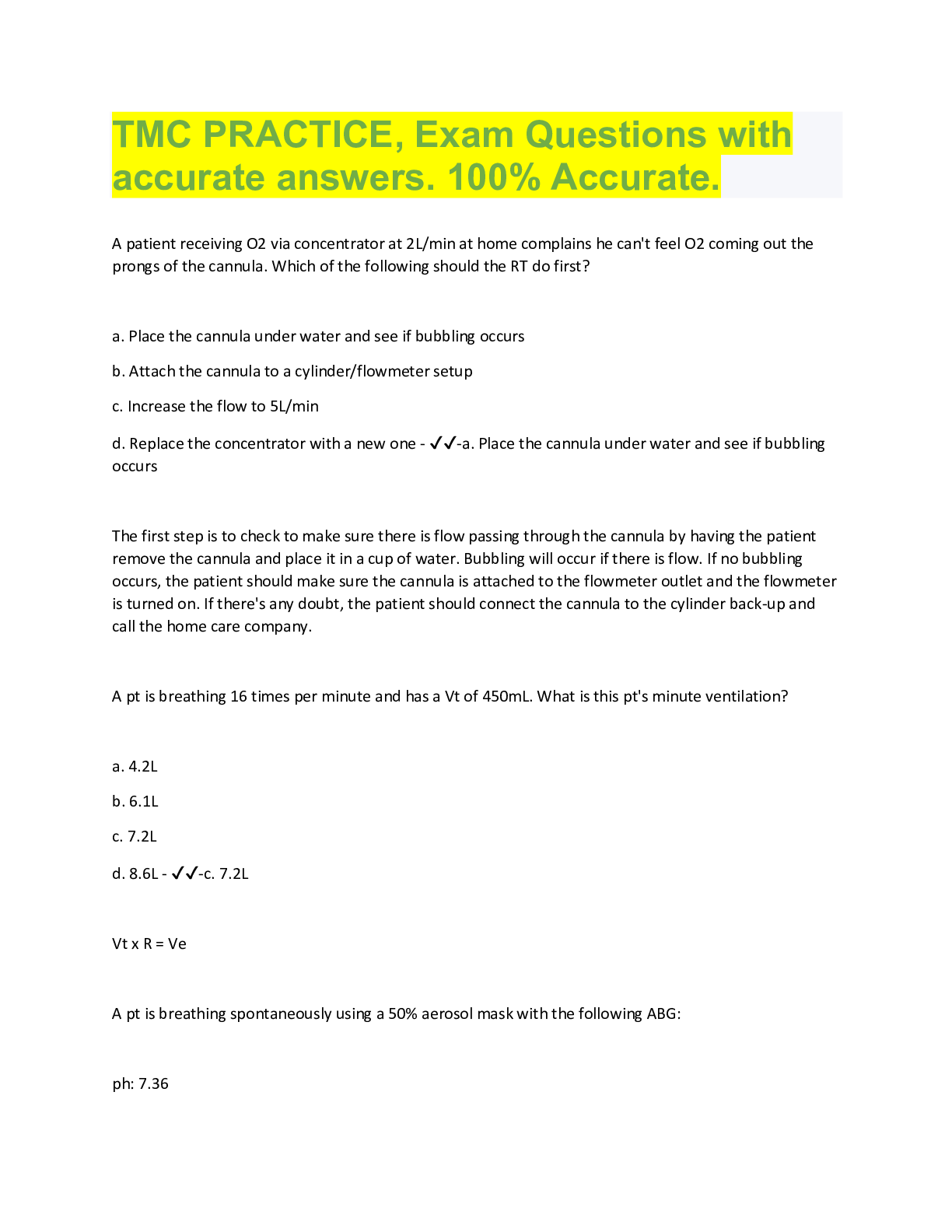
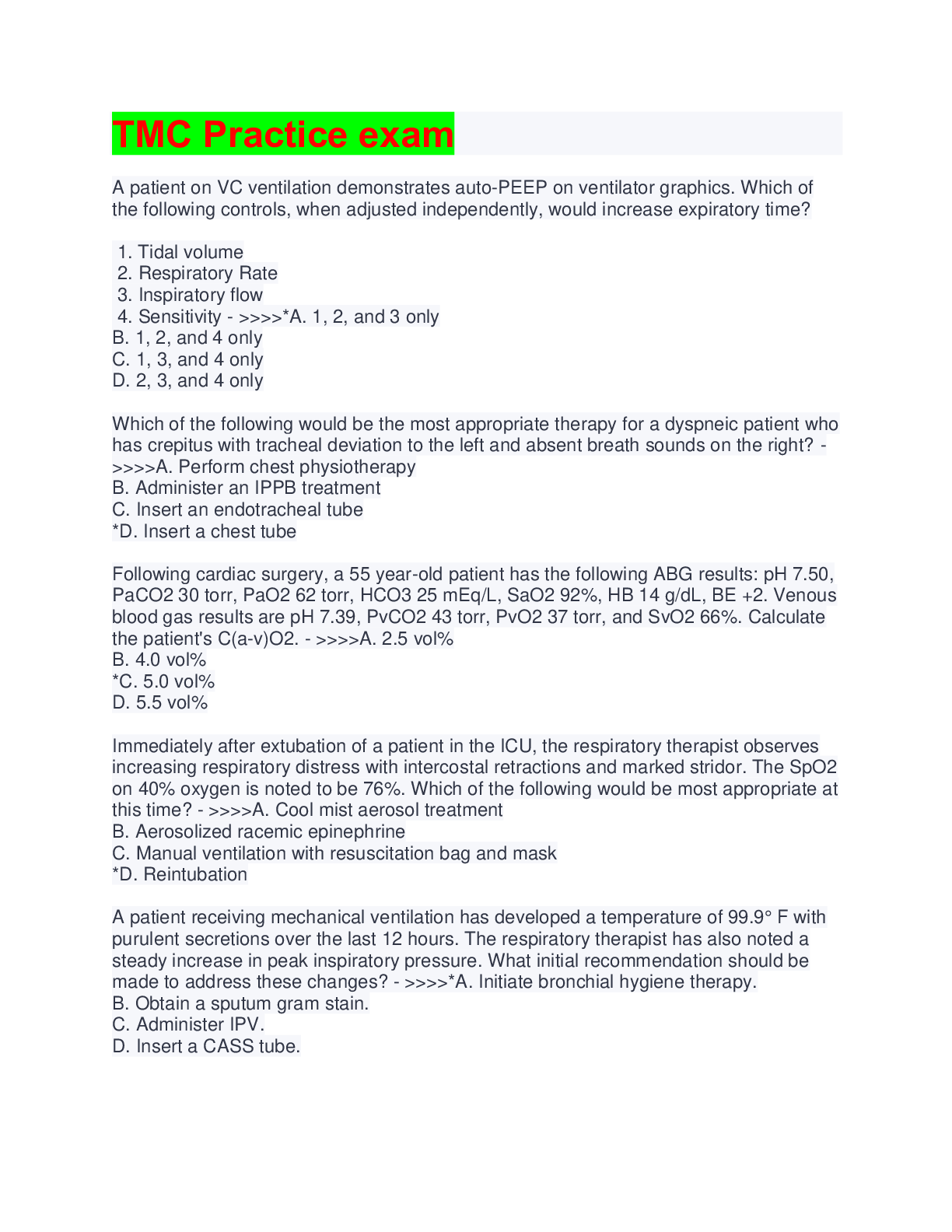
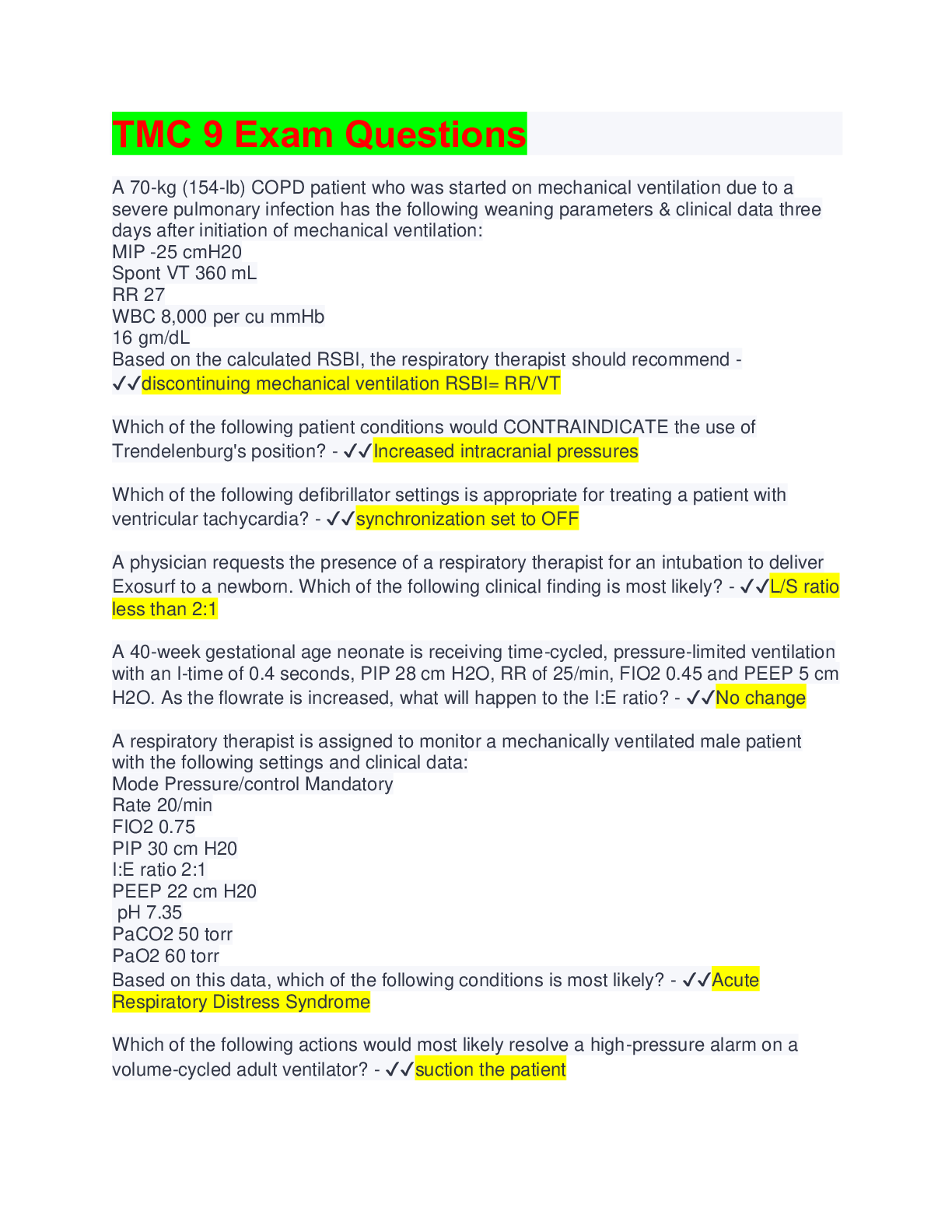
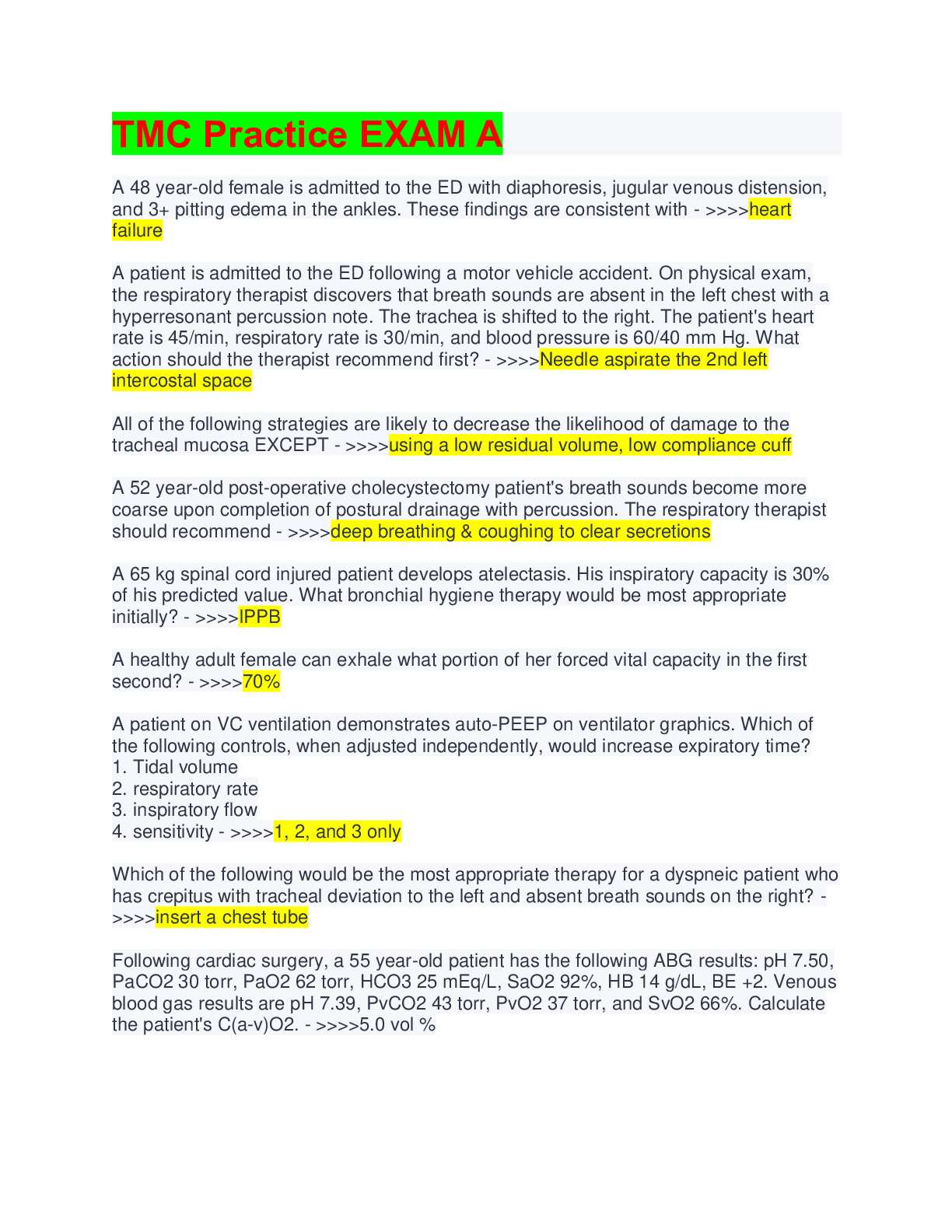
.png)
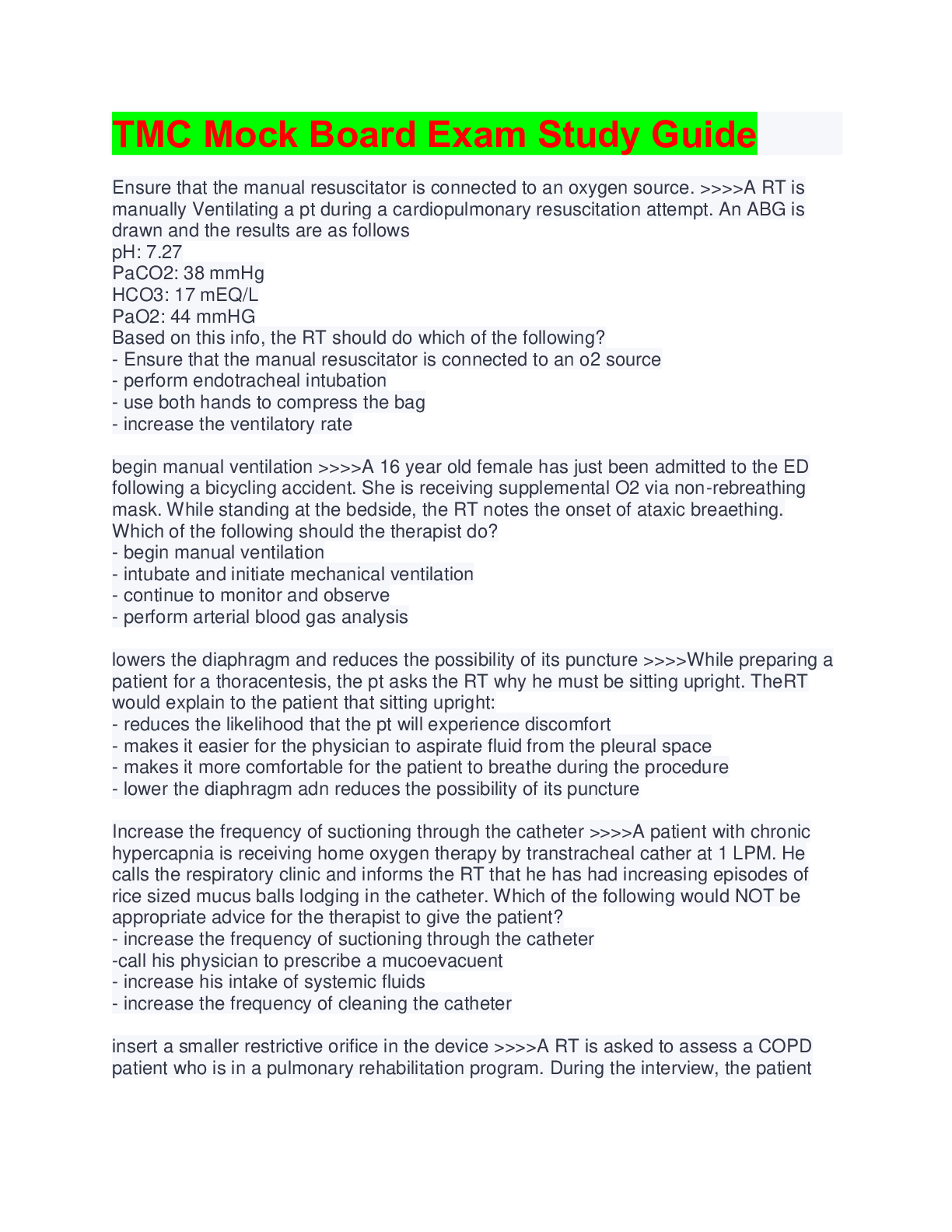

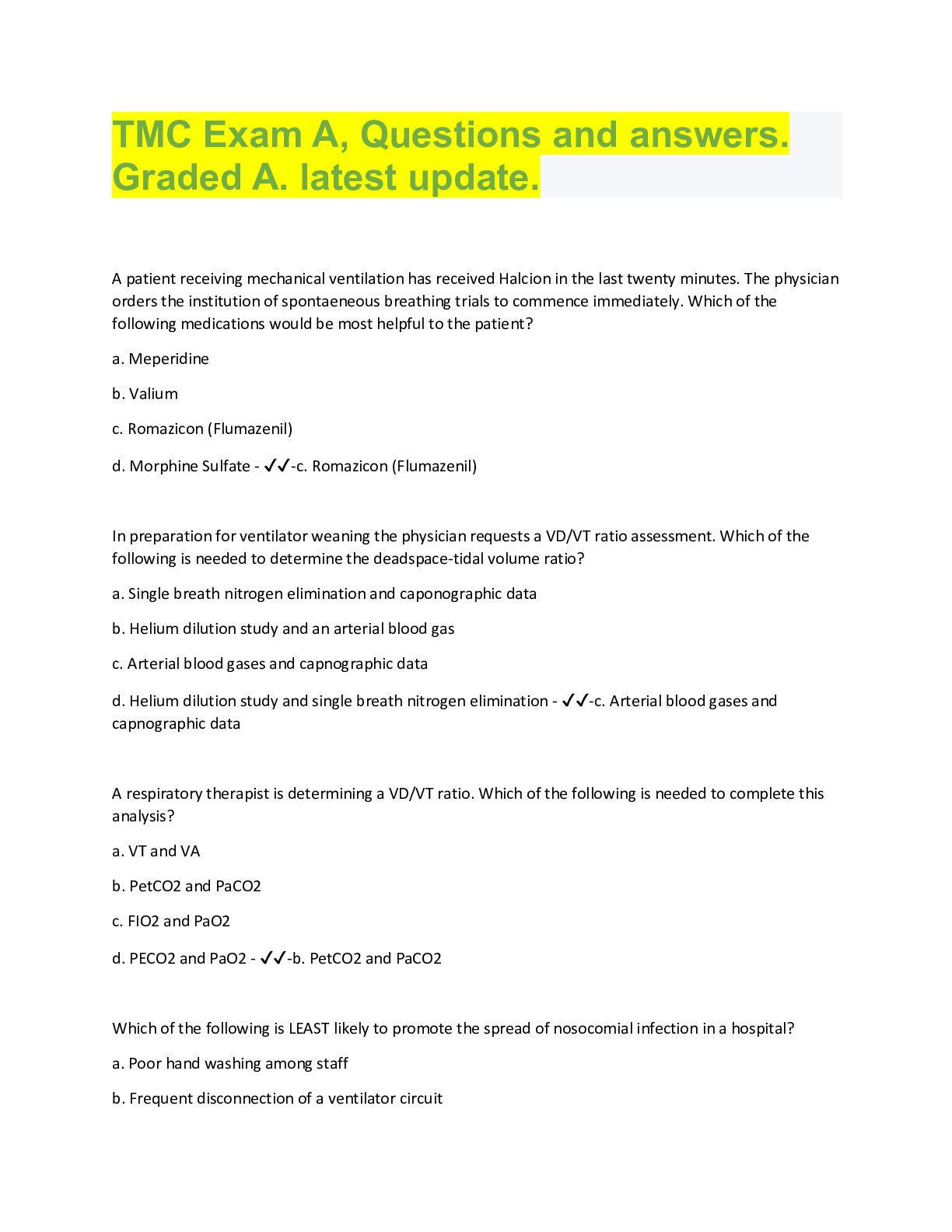
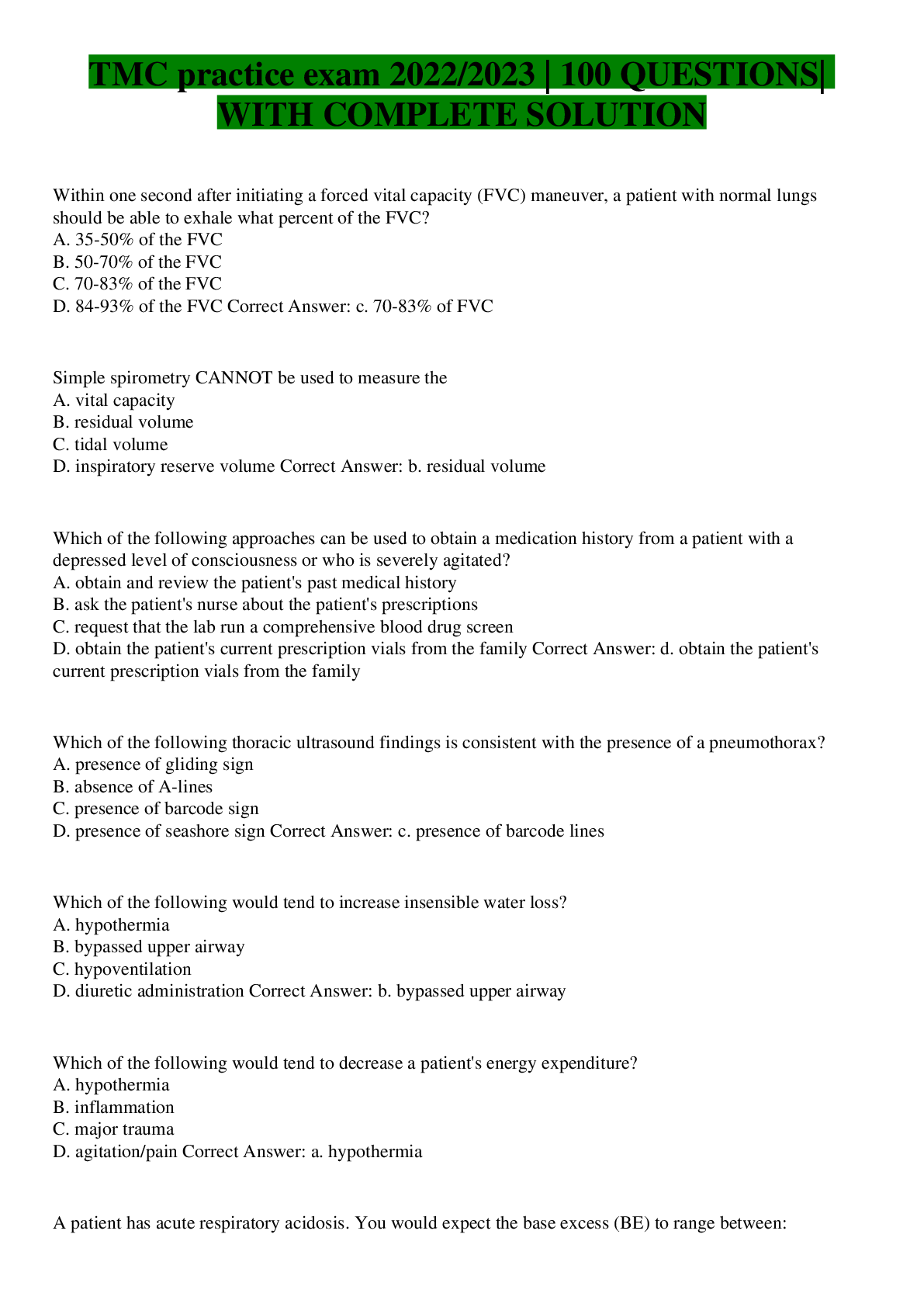
.png)

